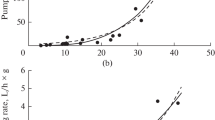Abstract
Suspension-feeding behavior of the adult barnacleSemibalanus balanoides (L.), collected at Woods Hole, USA, in 1987 and 1988, was studied in variable conditions of unidirectional and oscillating water flow. Barnacles growing on rocks were placed in a laboratory flume and exposed to precise patterns of water flow created with a specially designed electronic-circuit controlling a motor-driven propeller submersed in the flume. Laser darkfield and brightfield illumination were used to video-record the movement of suspended particles and dye in the flume and barnacle activity. When water was accelerated unidirectionally past feeding barnacles, they consistently changed feeding behavior from actively sweeping their thoracic appendages (cirri) through the water in slow-flow to passively holding cirri into the current in faster flow. The mean water velocity at which this behavioral switch occurred was 3.10 cm s−1. In slow-flow, each active sweep of the cirri created a feeding vortex that caused suspended particles to swirl into the capture zone of the following sweep. Barnacles in simulated wave-action conditions (oscillatory flow) fed passively, and orientated extended cirri to flow direction. Cirri were rapidly reoriented with the same frequency at which flow direction reversed. Slow-motion analysis of one barnacle feeding in oscillating flow (0.65 Hz) indicated that reversal of the orientation of the cirri began 0.19 s before the water itself started to reverse direction. In additional experiments, barnacles were exposed to a repetitive pattern of accelerating-decelerating flow. During each flow cycle, barnacles switched from active to passive feeding as water accelerated. Repeated exposure of an individual to the same flow-cycle caused a consistent decrease in the water-velocity threshold at which the behavioral switch occurred.
Similar content being viewed by others
Literature cited
Anderson, D. T., Southward, A. J. (1987). Cirral activity of barnacles. In: Southward, A. J. (ed.) Crustacean, issues 5, Barnacle biology. A. A. Balkema, Rotterdam, p. 135–174
Barnes, R. D. (1966). Invertebrate zoology. W. B. Saunders Co., Philadelphia
Bascom, W. (1980). Waves and beaches. Anchor Press/Doubleday, Garden City, New York
Baumiller, T. K. (1988). Effects of filter porosity and shape on fluid flux: implications for the biology and evolutionary history of stalked crinoids. In: Burke, R. D., Mladenov, P., Lambert, P., Parsley, R. L. (eds.) Proc. 6th int. Echinoderm biol. Conf. (1987), Victoria, British Colombia, p. 786
Crisp, D. J., Southward, A. J. (1961). Different types of cirral activity of barnacles. Phil. Trans. R. Soc. (Ser. B) 243: 271–308
Denny, M. W. (1988). Biology and the mechanics of wave-swept environments. Princeton University Press, Princeton, New Jersey
Holland, N. D., Strickler, J. R., Leonard, A. B. (1986). Particle interception, transport and rejection by the feather starOligometra serripinna (Echinodermata: Crinoidea), studied by frame analysis of videotapes. Mar. Biol. 93: 111–126
Jørgensen, C. B. (1966). Biology of suspension feeding. Pergamon Press, Oxford
LaBarbera, M. (1977). Brachiopod orientation to water current. I. Theory, laboratory behavior, and field orientations. Paleobiology 3: 270–287
Okamura, B. (1985). The effects of ambient flow velocity, colony size, and upstream colonies on the feeding success of Bryozoa. II.Conopeum reticulum (Linnaeus), an encrusting species. J. exp. mar. Biol. Ecol. 83: 69–80
Southward, A. J. (1955). On the behavior of barnacles II. The influence of habitat and tide level on cirral activity. J. mar. biol. Ass. U.K. 34: 423–433
Southward, A. J. (1957). On the behavior of barnacles. III. Further observations on the influence of temperature and age on cirral activity. J. mar. biol. Ass. U.K. 36: 323–334
Southward, A. J., Crisp, D. J. (1965). Activity rhythms of barnacles in relation to respiration and feeding. J. mar. biol. Ass. U.K. 45: 161–185
Spielman, L., Goren, S. L. (1968). Model for predicting pressure drop and filtration efficiency in fibrous media. Envir. Sci. Technol. 2: 279–287
Strickler, J. R. (1985). Feeding currents in calanoid copepods: two new hypotheses. Symp. Soc. exp. Biol. 39: 459–485
Vogel, S. (1981). Life in moving fluids, the physical biology of flow. Willard Grant Press, Boston
Vogel, S., LaBarbera, M. (1978). Simple flow tanks for research and teaching. BioSci. 28: 638–643
Wells, H., Wells, M. J., Gray, I. E. (1960). On the southern limits ofBalanus balanoides in the western Atlantic. Ecology 41: 578–580
Author information
Authors and Affiliations
Additional information
Communicated by J. Grassle, Woods Hole
Rights and permissions
About this article
Cite this article
Trager, G.C., Hwang, J.S. & Strickler, J.R. Barnacle suspension-feeding in variable flow. Mar. Biol. 105, 117–127 (1990). https://doi.org/10.1007/BF01344277
Accepted:
Issue Date:
DOI: https://doi.org/10.1007/BF01344277




